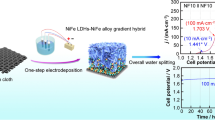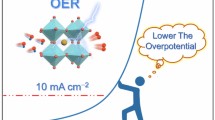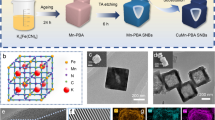Abstract
Developing efficient and stable bimetallic Pd-based anode electrocatalysts toward formic acid oxidation (FAO) is of great significance for commercial applications of direct formic acid fuel cells (DFAFCs). Herein, we report a facile synthesis approach to fabricate PdCu nanoclusters (NCs) catalysts with granular-film structure. The introduction of Cu can adjust the electronic structure and d-band center of Pd, which can improve the catalytic performance of the catalysts. Compared with Pd NCs catalyst, the catalytic durability and activity of PdCu NCs catalysts for FAO are greatly improved. The order for catalytic activity of NC metals is Pd85Cu15 NCs > Pd70Cu30 NCs > Pd NCs. The maximum mass activity can be acquired with the Pd85Cu15 NCs catalyst, which is about 1.7 times that of the Pd NCs catalyst. And Pd85Cu15 NCs catalyst still maintains the highest catalytic current density after 50 cycles, indicating that Pd85Cu15 NCs catalyst has the best durability and electrocatalytic activity for FAO. Our work provides a new prospect for the design of highly efficient anode catalysts materials for DFAFCs.
Graphical Abstract

摘要
开发高效, 稳定的双金属Pd基阳极催化剂用于甲酸氧化(FAO)对于直接甲酸燃料电池(DFAFCs)的商业应用具有重要意义。我们通过一种简便的合成方法制备了具有颗粒膜结构的PdCu纳米团簇(NCs)催化剂。Cu的引入可以调整Pd的电子结构和d能带中心, 从而提高催化剂的催化性能。与Pd NCs催化剂相比, PdCu NCs催化剂对FAO的催化耐久性和活性均有所提高, 催化活性大小依次为: Pd85Cu15 NCs > Pd70Cu30 NCs > Pd NCs。Pd85Cu15 NCs催化剂具有最大的质量活性, 约为Pd NCs催化剂的1.7倍。此外, Pd85Cu15 NCs催化剂在50次循环后仍保持最高的电流密度, 说明Pd85Cu15 NCs催化剂用于甲酸氧化具有最佳的催化耐久性和活性。我们的工作为DFAFCs阳极催化剂的设计提供了新的思路。








Similar content being viewed by others
References
Li CZ, Yuan Q, Ni B, He T, Zhang SM, Long Y, Gu L, Wang X. Dendritic defect-rich palladium-copper-cobalt nanoalloys as robust multifunctional non-platinum electrocatalysts for fuel cells. Nat Commun. 2018;9:3702.
Zhang Y, Yuan XL, Lyu FL, Wang XC, Jiang XJ, Cao MH, Zhang Q. Facile one-step synthesis of PdPb nanochains for high-performance electrocatalytic ethanol oxidation. Rare Met. 2020;39(7):792.
Ji XL, Lee KT, Holden R, Zhang L, Zhang JJ, Botton GA, Couillard M, Nazar LF. Nanocrystalline intermetallics on mesoporous carbon for direct formic acid fuel cell anodes. Nat Chem. 2010;2(4):286.
Chang JF, Feng LG, Liu CP, Xing W, Hu XL. An effective Pd-Ni2P/C anode catalyst for direct formic acid fuel cells. Angew Chem Int Edit. 2014;53(1):122.
Liu H, Li XX, Liu XY, Ma ZH, Yin ZY, Yang WW, Yu YS. Schiff-base-rich g-CxN4 supported PdAg nanowires as an efficient Mott-Schottky catalyst boosting photocatalytic dehydrogenation of formic acid. Rare Met. 2021;40(4):808.
Yan XX, Hu XJ, Fu GT, Xu L, Lee JM, Tang YW. Facile synthesis of porous Pd3Pt half-shells with rich “active sites” as efficient catalysts for formic acid oxidation. Small. 2018;14(13):1703940.
Goswami C, Saikia H, Tada K, Tanaka S, Sudarsanam P, Bhargava SK, Bharali P. Bimetallic palladium nickel nanoparticles anchored on carbon as high-performance electrocatalysts for oxygen reduction and formic acid oxidation reactions. Acs Appl Energ Mater. 2020;3(9):9285.
Sui LJ, An W, Feng YH, Wang ZM, Zhou JW, Hur SH. Bimetallic Pd-based surface alloys promote electrochemical oxidation of formic acid: mechanism, kinetics and descriptor. J Power Sources. 2020;451:227830.
Hu SZ, Che FL, Khorasani B, Jeon M, Yoon CW, McEwen JS, Scudiero L, Ha S. Improving the electrochemical oxidation of formic acid by tuning the electronic properties of Pd-based bimetallic nanoparticles. Appl Catal B-Environ. 2019;254:685.
Zhan ZJ, Li X, Cao HY. Design and properties of new Fe-Cu composites. Chin J Rare Met. 2020;44(2):153.
Kortlever R, Balemans C, Kwon Y, Koper MTM. Electrochemical CO2 reduction to formic acid on a Pd-based formic acid oxidation catalyst. Catal Today. 2015;244:58.
Liao MY, Li WP, Peng JX, Zhang F, Xu WY, Huang ZC. Enhancement of anodic oxidation of formic acid on Pd-Fe bimetallic nanoparticles by thermal treatment. Int J Hydrogen Energ. 2021;46(17):10239.
Wang RF, Liao SJ, Ji S. High performance Pd-based catalysts for oxidation of formic acid. J Power Sources. 2008;180(1):205.
Liu KX, Wang L, Zhang HM, Yu HJ, Sui T, Jin SZ. Preparation and characterization of Cu/AlN/Cu gradient composite electrode materials. Chin J Rare Met. 2020;44(12):1264.
Bao YF, Feng LG. Formic acid electro-oxidation catalyzed by PdNi/graphene aerogel. Acta Phys-Chim Sin. 2021;37(9):2008031.
Liang WK, Wang YW, Zhao L, Guo W, Li D, Qin W, Wu HH, Sun YH, Jiang L. 3D anisotropic Au@Pt-Pd hemispherical nanostructures as efficient electrocatalysts for methanol, ethanol, and formic acid oxidation reaction. Adv Mater. 2021;33(30):2100713.
Xu H, Yan B, Zhang K, Wang J, Li SM, Wang CQ, Shiraishi Y, Du YK, Yang P. Facile fabrication of novel PdRu nanoflowers as highly active catalysts for the electrooxidation of methanol. J Colloid Interf Sci. 2017;505:1.
Lu L, Shen LP, Shi Y, Chen TT, Jiang GQ, Ge CW, Tang YW, Chen Y, Lu TH. New insights into enhanced electrocatalytic performance of carbon supported Pd-Cu catalyst for formic acid oxidation. Electrochim Acta. 2012;85:187.
Lu LF, Wang B, Wu D, Zou SH, Fang BZ. Engineering porous Pd-Cu nanocrystals with tailored three-dimensional catalytic facets for highly efficient formic acid oxidation. Nanoscale. 2021;13(6):3709.
Song JL, Zhong HC, Wu H, Xiao ZJ, Song HY, Shu T, Zeng JH. Robust and efficient Pd-Cu bimetallic catalysts with porous structure for formic acid oxidation and a mechanistic study of electrochemical dealloying. Electrocatalysis. 2021;12(2):117.
Zheng JZ, Zeng HJ, Tan CH, Zhang TM, Zhao B, Guo W, Wang HB, Sun YH, Jiang L. Coral-like PdCu alloy nanoparticles act as stable electrocatalysts for highly efficient formic acid oxidation. Acs Sustain Chem Eng. 2019;7(8):15354.
Liu JY, Cao JY, Huang QH, Li XW, Zou ZQ, Yang H. Methanol oxidation on carbon-supported Pt-Ru-Ni ternary nanoparticle electrocatalysts. J Power Sources. 2008;175(1):159.
Yin Z, Zhou W, Gao YJ, Ma D, Kiely CJ, Bao XH. Supported Pd-Cu bimetallic nanoparticles that have high activity for the electrochemical oxidation of methanol. Chem-Eur J. 2012;18(16):4887.
Yang NL, Zhang ZC, Chen B, Huang Y, Chen JZ, Lai ZC, Chen Y, Sindoro M, Wang AL, Cheng HF, Fan ZX, Liu XZ, Li B, Zong Y, Gu L, Zhang H. Synthesis of ultrathin PdCu alloy nanosheets used as a highly efficient electrocatalyst for formic acid oxidation. Adv Mater. 2017;29(29):1700769.
Mori K, Naka K, Masuda S, Miyawaki K, Yamashita H. Palladium copper chromium ternary nanoparticles constructed insitu within a basic resin: enhanced activity in the dehydrogenation of formic acid. ChemCatChem. 2017;9(18):3456.
Cai JD, Zeng YZ, Guo YL. Copper@palladium-copper core-shell nanospheres as a highly effective electrocatalyst for ethanol electro-oxidation in alkaline media. J Power Sources. 2014;270:257.
Li SN, Zhai YN, Zhang XY, MacFarlane DR. Surfactant-free synthesis of graphene-supported PdCu nanocrystals with high alloying degree as highly active catalyst for formic acid electrooxidation. Adv Mater Interfaces. 2017;4(14):1700227.
Hu SZ, Munoz F, Noborikawa J, Haan J, Scudiero L, Ha S. Carbon supported Pd-based bimetallic and trimetallic catalyst for formic acid electrochemical oxidation. Appl Catal B-Environ. 2016;180:758.
Wang L, Zhai JJ, Jiang K, Wang JQ, Cai WB. Pd-Cu/C electrocatalysts synthesized by one-pot polyol reduction toward formic acid oxidation: structural characterization and electrocatalytic performance. Int J Hydrogen Energ. 2015;40(4):1726.
Wang X, Tang Y, Gao Y, Lu TH. Carbon-supported Pd-Ir catalyst as anodic catalyst in direct formic acid fuel cell. J Power Sources. 2008;175:784.
Yang L, Hu CG, Wang JL, Yang ZX, Guo YM, Bai ZY, Wang K. Facile synthesis of hollow palladium/copper alloyed nanocubes for formic acid oxidation. Chem Commun. 2011;47(30):8581.
Ma YX, Yin LS, Cao GJ, Huang QL, He MS, Wei WX, Zhao H, Zhang DG, Wang MY, Yang T. Pt-Pd bimetal popcorn nanocrystals: enhancing the catalytic performance by combination effect of stable multipetals nanostructure and highly accessible active sites. Small. 2018;14(14):1703613.
Yu PE, Xu H, Jin LJ, Chen CY, Shang HY, Liu QY, Du YK. A novel catalyst for efficient electrooxidation of ethanol enabled by 3D open-structured PdCu nanocages. J Colloid Interf Sci. 2019;555:195.
Pramanick B, Kumar T, Halder A, Siril PF. Engineering the morphology of palladium nanostructures to tune their electrocatalytic activity in formic acid oxidation reactions. Nanoscale Adv. 2020;2(12):5810.
Geng JR, Zhu Z, Ni YX, Li HX, Cheng FY, Li FJ, Chen J. Biaxial strained dual-phase palladium-copper bimetal boosts formic acid electrooxidation. Nano Res. 2021;15(1):280.
Ye N, Bai YX, Jiang Z, Fang T. Component-dependent activity of bimetallic PdCu and PdNi electrocatalysts for methanol oxidation reaction in alkaline media. Int J Hydrogen Energ. 2020;45(56):32022.
Dong QZ, Zeng WX, Wan HS, Yu SM, Guo CC, Huang ML. Highly effective PdCu electrocatalysts supported on polyelectrolyte functionalized titanium dioxide for direct formic acid fuel cells. Int J Electrochem Sci. 2017;12:1389.
Choi KI, Vannice MA. CO oxidation over Pd and Cu catalysts IV. Prereduced Al2O3-supported copper. J Catal. 1991;131(1):22.
Rochefort A, Abon M, Delichere P, Bertolini JC. Alloying effect on the adsorption properties of Pd50Cu50 {111} single crystal surface. Surf Sci. 1993;294(1–2):43.
Papadimitriou S, Tegou A, Pavlidou E, Armyanov S, Valova E, Kokkinidis G, Sotiropoulos S. Preparation and characterisation of platinum- and gold-coated copper, iron, cobalt and nickel deposits on glassy carbon substrates. Electrochim Acta. 2008;53(22):6559.
Acknowledgments
This study was financially supported by the National Natural Science Foundation of China (No. 51901197, 51971184 and 51771157), the Open Fund of Fujian Provincial Key Laboratory of Eco-Industrial Green Technology in Wuyi University (No. WYKF-EIGT2021-6).
Author information
Authors and Affiliations
Corresponding authors
Ethics declarations
Conflict of interests
The authors declare that they have no conflict of interest.
Rights and permissions
About this article
Cite this article
Ding, QW., Luo, Q., Lin, L. et al. Facile synthesis of PdCu nanocluster-assembled granular films as highly efficient electrocatalysts for formic acid oxidation. Rare Met. 41, 2595–2605 (2022). https://doi.org/10.1007/s12598-022-01997-0
Received:
Revised:
Accepted:
Published:
Issue Date:
DOI: https://doi.org/10.1007/s12598-022-01997-0




